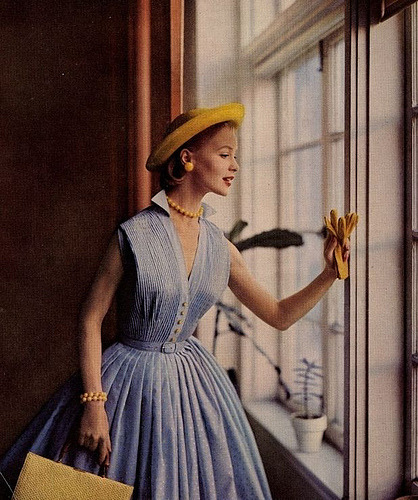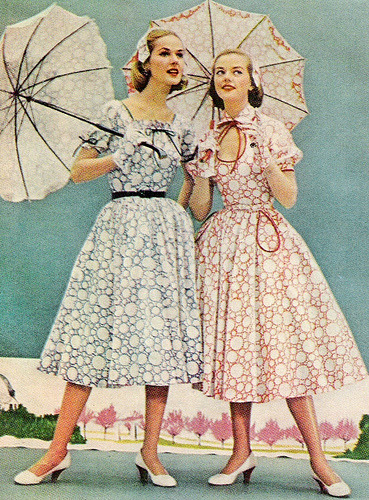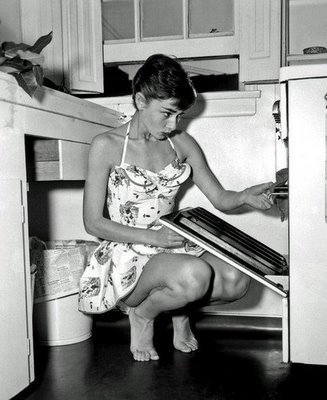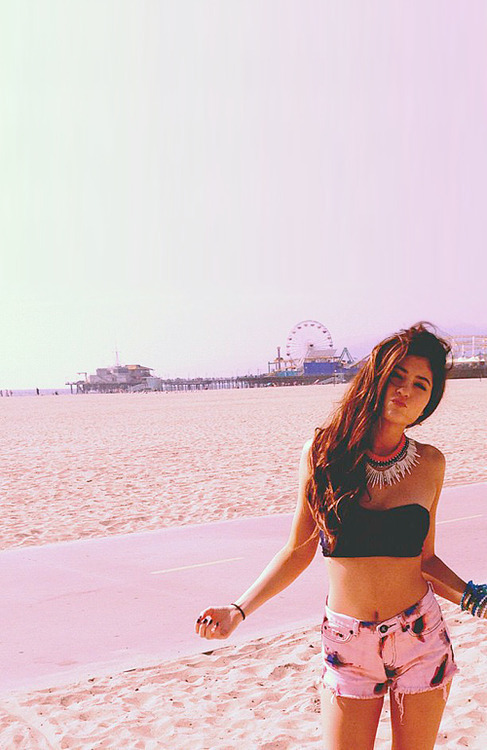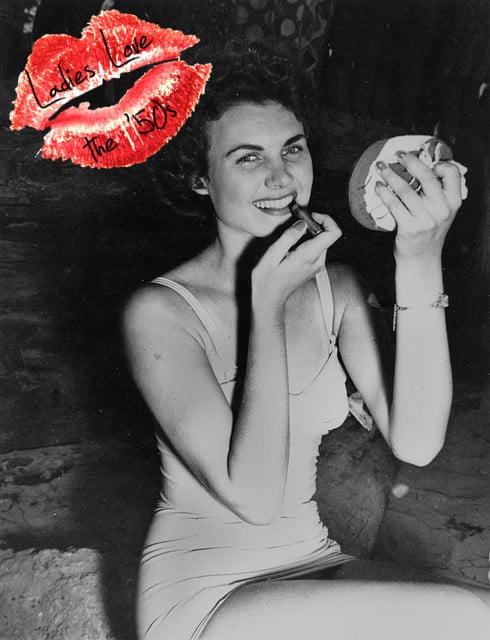50s Fashion
The 1950s was a decade known for experimentation with new styles and culture. Following World War II and the austerity years of the post-war period, the 1950s were a time of comparative prosperity, which influenced fashion and the concept of glamour. Hairstylists invented new hairstyles for wealthy patrons. Influential hairstylists of the period include Sydney Guilaroff, Alexandre of Paris and Raymond Bessone who took French hair fashion to the Hollywood, New York and London, popularising the artichoke cut, the pixie cut and bouffant hairstyles.
The American film industry, and popular music industry influenced hairstyles around the world, both in mainstream fashion and teenage sub-culture. With the advent of the rock music industry, teenage culture, and teenage fashion became increasingly significant and distinctive from mainstream fashion, with American style being imitated in Europe, Asia, Australasia and South America. Teenage girls across the world wore their hair in ponytails while teenage boys wore crew cuts, and the more rebellious favoured "greaser" comb-backs.
The development of hair-styling products, particularly setting sprays, hair-oil and hair-cream, influenced the way in which hair was styled, and the way in which people across the world wore their hair, from day to day. Women's hair styles of the 50s were in general less ornate and more informal than those of the 40s, with a "natural" look being favoured, even if it was achieved by perming, setting, styling and spraying. Mature men's hairstyles were always short and neat, and generally maintained with hair-oil. Even among "rebellious youth" with longer greased hair, carrying a comb and maintaining the hairstyle was part of the culture.
Popular music and film stars had a major influence on 50s hairstyles and fashion. Elvis Presley and James Dean had a great influence on the high quiff/pompadour greased-up style or slicked back style for men with heavy use of Brylcreem or gel. The pompadour was a fashion trend in the 1950s, especially among male rockabilly artists and actors. A variation of this was the Duck's Ass (or in the UK "Duck's Arse"), also called the "Duck's Tail", the "Ducktail", or simply the D.A.[1] This hairstyle was originally developed by Joe Cerello in 1940. Cerello's clients later included film celebrities like Elvis Presley and James Dean.[2] Even Frank Sinatra posed in a modified D.A. style of hair. This style required that the hair be combed back around the sides of the head. The tooth edge of a comb was then used to define a central part running from the crown to the nape at the back of the head, resembling, to many, the rear end of a duck. The hair on the top front of the head was either deliberately disarrayed so that untidy strands hung down over the forehead, or combed up and then curled down into an "Elephant's trunk" which might hang down as far as the top of the nose. The sides were styled to resemble the folded wings of the duck, often with heavy sideburns.[3] A variant of the Duck's ass style, known as "the Detroit", consisted of the long back and sides combined with a flattop. In California, the top hair was allowed to grow longer and combed into a wavelike pompadour shape known as a "breaker". The Duck's tail became an emblematic coiffure of disaffected young males across the English-speaking world during the 1950s, a sign of rebellious youth and of a "bad boy" image.[4][5][1] The style was frowned upon by high school authorities, who often imposed limitations on male hair length as part of their dress code.[6] Nevertheless, the style was widely copied by men of all ages.[2]
The 1950s was a decade known for experimentation with new styles and culture. Following World War II and the austerity years of the post-war period, the 1950s were a time of comparative prosperity, which influenced fashion and the concept of glamour. Hairstylists invented new hairstyles for wealthy patrons. Influential hairstylists of the period include Sydney Guilaroff, Alexandre of Paris and Raymond Bessone who took French hair fashion to the Hollywood, New York and London, popularising the artichoke cut, the pixie cut and bouffant hairstyles.
The American film industry, and popular music industry influenced hairstyles around the world, both in mainstream fashion and teenage sub-culture. With the advent of the rock music industry, teenage culture, and teenage fashion became increasingly significant and distinctive from mainstream fashion, with American style being imitated in Europe, Asia, Australasia and South America. Teenage girls across the world wore their hair in ponytails while teenage boys wore crew cuts, and the more rebellious favoured "greaser" comb-backs.
The development of hair-styling products, particularly setting sprays, hair-oil and hair-cream, influenced the way in which hair was styled, and the way in which people across the world wore their hair, from day to day. Women's hair styles of the 50s were in general less ornate and more informal than those of the 40s, with a "natural" look being favoured, even if it was achieved by perming, setting, styling and spraying. Mature men's hairstyles were always short and neat, and generally maintained with hair-oil. Even among "rebellious youth" with longer greased hair, carrying a comb and maintaining the hairstyle was part of the culture.
Popular music and film stars had a major influence on 50s hairstyles and fashion. Elvis Presley and James Dean had a great influence on the high quiff/pompadour greased-up style or slicked back style for men with heavy use of Brylcreem or gel. The pompadour was a fashion trend in the 1950s, especially among male rockabilly artists and actors. A variation of this was the Duck's Ass (or in the UK "Duck's Arse"), also called the "Duck's Tail", the "Ducktail", or simply the D.A.[1] This hairstyle was originally developed by Joe Cerello in 1940. Cerello's clients later included film celebrities like Elvis Presley and James Dean.[2] Even Frank Sinatra posed in a modified D.A. style of hair. This style required that the hair be combed back around the sides of the head. The tooth edge of a comb was then used to define a central part running from the crown to the nape at the back of the head, resembling, to many, the rear end of a duck. The hair on the top front of the head was either deliberately disarrayed so that untidy strands hung down over the forehead, or combed up and then curled down into an "Elephant's trunk" which might hang down as far as the top of the nose. The sides were styled to resemble the folded wings of the duck, often with heavy sideburns.[3] A variant of the Duck's ass style, known as "the Detroit", consisted of the long back and sides combined with a flattop. In California, the top hair was allowed to grow longer and combed into a wavelike pompadour shape known as a "breaker". The Duck's tail became an emblematic coiffure of disaffected young males across the English-speaking world during the 1950s, a sign of rebellious youth and of a "bad boy" image.[4][5][1] The style was frowned upon by high school authorities, who often imposed limitations on male hair length as part of their dress code.[6] Nevertheless, the style was widely copied by men of all ages.[2]
50s Fashion
50s Fashion
50s Fashion
50s Fashion
50s Fashion
50s Fashion
50s Fashion
50s Fashion
50s Fashion
50s Fashion
50s Fashion
50s Fashion
50s Fashion
50s Fashion
50s Fashion
50s Fashion
50s Fashion
50s Fashion
50s Fashion
50s Fashion

